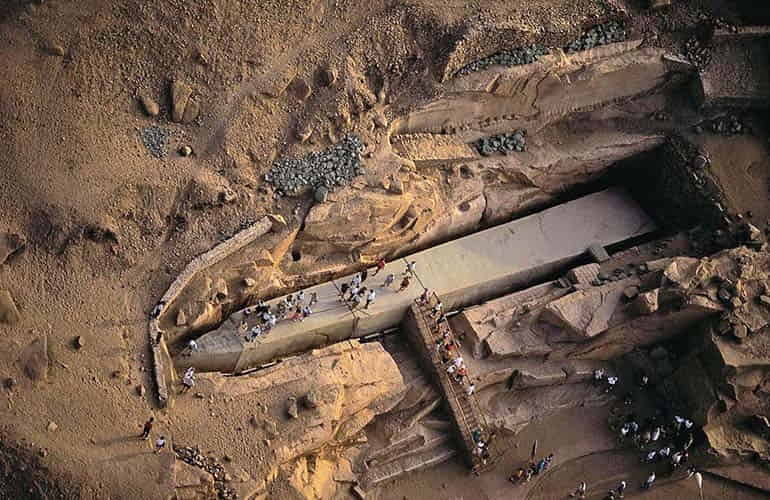Unfinished Obelisk In Aswan
A gigantic obelisk, dating from the New Kingdom, lies semi-finished in an ancient granite quarry just south of Aswan. Had it been completed, it would have weighed a staggering 1.8 million kg (1,197 tons) and stood 41 m (134 ft) high.
Three sides of the shaft were quarried before a flaw was discovered in the stone and the obelisk had to be abandoned, still partly attached to the parent rock.
To the west of the quarry, the Fatimid cemetery contains several hundred mudbricks Islamic tombs, built between the 8th and 12th centuries.
The unfinished obelisk is an Egyptian obelisk whose size has been abandoned, probably as a result of a crack in the rock. It lies in a rough state, not detached from the rock mass, in a large pink granite quarry two kilometers south of Syene (Aswan).

The quarries of Aswan
The exploitation of granite, schist and alabaster quarries has been one of the region’s riches since antiquity. The blocks were transported northwards by the Nile river. The obelisks erected in Rome, New York, Istanbul, Paris, and London were carved from Aswan granite, a rock found only in this southern region of Egypt.
A few kilometers south of Aswan several quarries provided the precious pink granite for the obelisks, but also the stone blocks for the pyramids, statues, and royal colossuses.
Cutting techniques
This gigantic obelisk gives an indication of how these monuments were carved into the granite massif. Probably because of a defect in the rock, the workers abandoned it, without detaching it from the ground. This state of incompleteness allows us to better understand the extraction processes used by the Egyptians in ancient times: the state of the huge lateral grooves shows that the rock was attacked by percussion (most probably with hammers or dolerite balls), rather than by the technique common in Roman times of notches and wooden wedges swollen with water, or even metal wedges.
A homogeneous, crack-free rocky bench was first chosen and then its surface was flattened by applying hot bricks that were cooled suddenly with water. The granite was then rammed relentlessly with dolerite balls, many of which have been found naturally formed in the valleys of this desert region, both east and west of the river. These balls commonly weigh 5 kg and are 15 to 30 cm in diameter.
These lithic tools were used by patiently repeated vertical percussion, lifting and releasing them abruptly, in the manner of a tool called a lady or a goose. The result is very peculiar tool marks in the form of large, rounded grooves that appear to have been “nibbled”.
Delivery times
We do not know how long it would have taken to complete the construction, but we can get an idea from an inscription on the Hatshepsut obelisk in Karnak: the queen says that no one will probably believe her, but that her obelisk was completed and erected in just seven months.
Finishing, transportation of the obelisks
The blocks were probably finished and polished in situ, then hauled to the Nile and hoisted on barges, dry on the bank. Flooding refloated them and transport became possible.
Museum of the Unfinished Obelisk
An open-air museum has been established in the area of the unfinished obelisk in Aswan. In addition to this obelisk, it contains the remains of five other obelisks carved in Aswan granite; an inscription mentions that Thutmosis III, in the 25th year of his reign, ordered two obelisks for the Temple of Karnak: one of them is currently in Rome, the other is still in place in the temple.






